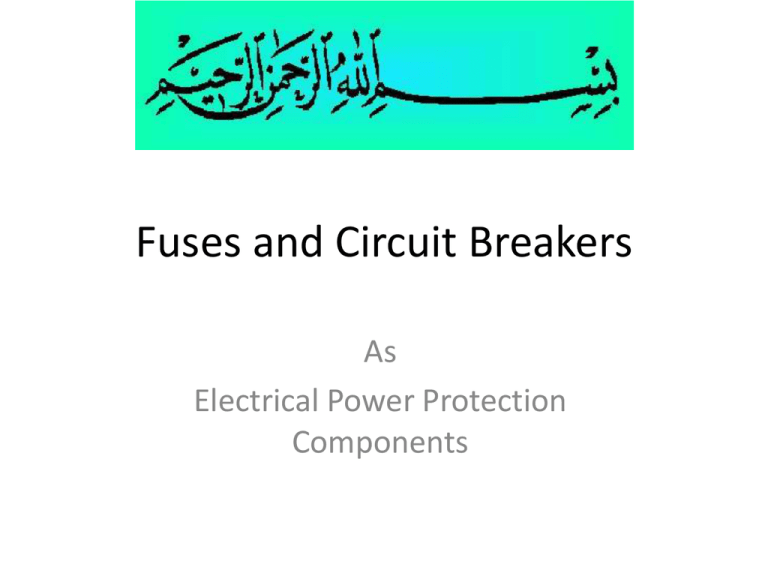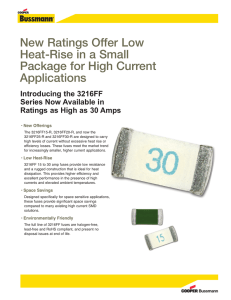Fuses and Circuit Breakers
advertisement

Fuses and Circuit Breakers As Electrical Power Protection Components Types and Symbols A miniature time-delay fuse used to protect electronic equipment, rated 0.3 amperes at 250 volts. 1.25 inches (about 32 mm) long 200 A Industrial fuse. 80 kA breaking capacity Electronic symbols for a fuse. IEC (upper) and IEEE/ANSI American/Canadian (lower two) versions. Function • A fuse interrupts excessive current (blows) so that further damage by overheating or fire is prevented. • Wiring regulations often define a maximum fuse current rating for particular circuits. • Overcurrent protection devices are essential in electrical systems to limit threats to human life and property damage. • Fuses are selected to allow passage of normal current and of excessive current only for short periods. Operation • A fuse consists of a metal strip or wire fuse element, of small cross-section compared to the circuit conductors, mounted between a pair of electrical terminals, and (usually) enclosed by a non-conducting and noncombustible housing. • The fuse is arranged in series to carry all the current passing through the protected circuit. The resistance of the element generates heat due to the current flow. • The size and construction of the element is (empirically) determined so that the heat produced for a normal current does not cause the element to attain a high temperature. If too high a current flows, the element rises to a higher temperature and either directly melts, or else melts a soldered joint within the fuse, opening the circuit. Characteristic Parameters • Rated current • Speed: ultrafast, fast-blow, slow-blow, or timedelay • Energy required to blow; I2t value • Breaking capacity: maximum current that can be interrupted • Rated voltage • Voltage drop • Temperature derating Fuse standards • IEC 60269 fuses – The International Electrotechnical Commission publishes standard 60269 for low-voltage power fuses. – The standard is in four volumes, which describe general requirements, fuses for industrial and commercial applications, fuses for residential applications, and fuses to protect semiconductor devices. – The IEC standard unifies several national standards, thereby improving the interchangeability of fuses in international trade. – All fuses of different technologies tested to meet IEC standards will have similar time-current characteristics, which simplifies design and maintenance. • UL 248 fuses (North America) Automotive fuses Thermal fuses • A thermal fuse is often found in consumer equipment such as coffee makers or hair dryers or transformers powering small consumer electronics devices. • They contain a fusible, temperature-sensitive alloy which holds a spring contact mechanism normally closed. When the surrounding temperature gets too high, the alloy melts and allows the spring contact mechanism to break the circuit. The device can be used to prevent a fire in a hair dryer for example, by cutting off the power supply to the heater elements when the air flow is interrupted (e.g., the blower motor stops or the air intake becomes accidentally blocked). • Thermal fuses are a 'one shot', non-resettable device which must be replaced once they have been activated (blown). Circuit breaker An air circuit breaker for low voltage (less than 1000 volts) power distribution switchgear A 2 pole miniature circuit breaker Four 1 pole circuit breakers Operation • A circuit breaker is an automatically operated electrical switch designed to protect an electrical circuit from damage caused by overload or short circuit. • Its basic function is to detect a fault condition and, by interrupting continuity, to immediately discontinue electrical flow. • Unlike a fuse, which operates once and then has to be replaced, a circuit breaker can be reset (either manually or automatically) to resume normal operation. • Circuit breakers are made in varying sizes, from small devices that protect an individual household appliance up to large switchgear designed to protect high voltage circuits feeding an entire city. Inside of a circuit breaker Inside of a circuit breaker 1. Actuator lever - used to manually trip and reset the circuit breaker. Also indicates the status of the circuit breaker (On or Off/tripped). 2. Actuator mechanism - forces the contacts together or apart. 3. Contacts - Allow current when touching and break the current when moved apart. 4. Terminals 5. Bimetallic strip. 6. Calibration screw - allows the manufacturer to precisely adjust the trip current of the device after assembly. 7. Solenoid 8. Arc divider/extinguisher Fuses compared with circuit breakers • Fuses have the advantages of often being less costly and simpler than a circuit breaker for similar ratings. • The blown fuse must be replaced with a new device which is less convenient than simply resetting a breaker and therefore likely to discourage people from ignoring faults. • On the other hand, replacing a fuse without isolating the circuit first (most building wiring designs do not provide individual isolation switches for each fuse) can be dangerous in itself, particularly if the fault is a short circuit. High current applications • High rupturing capacity fuses can be rated to safely interrupt up to 300,000 amperes at 600 V AC. Special current-limiting fuses are applied ahead of some molded-case breakers to protect the breakers in lowvoltage power circuits with high short-circuit levels. • Current-limiting fuses operate so quickly that they limit the total "let-through" energy that passes into the circuit, helping to protect downstream equipment from damage. These fuses open in less than one cycle of the AC power frequency; circuit breakers cannot match this speed. Maintenance • Some types of circuit breakers must be maintained on a regular basis to ensure their mechanical operation during an interruption. This is not the case with fuses, which rely on melting processes where no mechanical operation is required for the fuse to operate under fault conditions. • In a multi-phase power circuit, if only one fuse opens, the remaining phases will have higher than normal currents, and unbalanced voltages, with possible damage to motors. Fuses only sense overcurrent, or to a degree, overtemperature, and cannot usually be used independently with protective relaying to provide more advanced protective functions, for example, ground fault detection. More info • http://electronics.howstuffworks.com/circuit -breaker2.htm • Wikipedia, navigation, search, Circuit breaker (disambiguation) Results of Major_2 MCQ MCQ Max 30/50 Min 14/50 Average 21.7 Std Dev 5.06 Total # of students: 23



